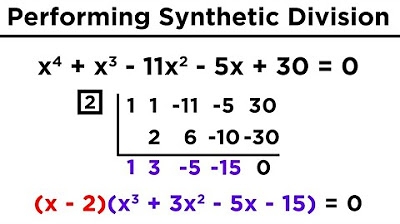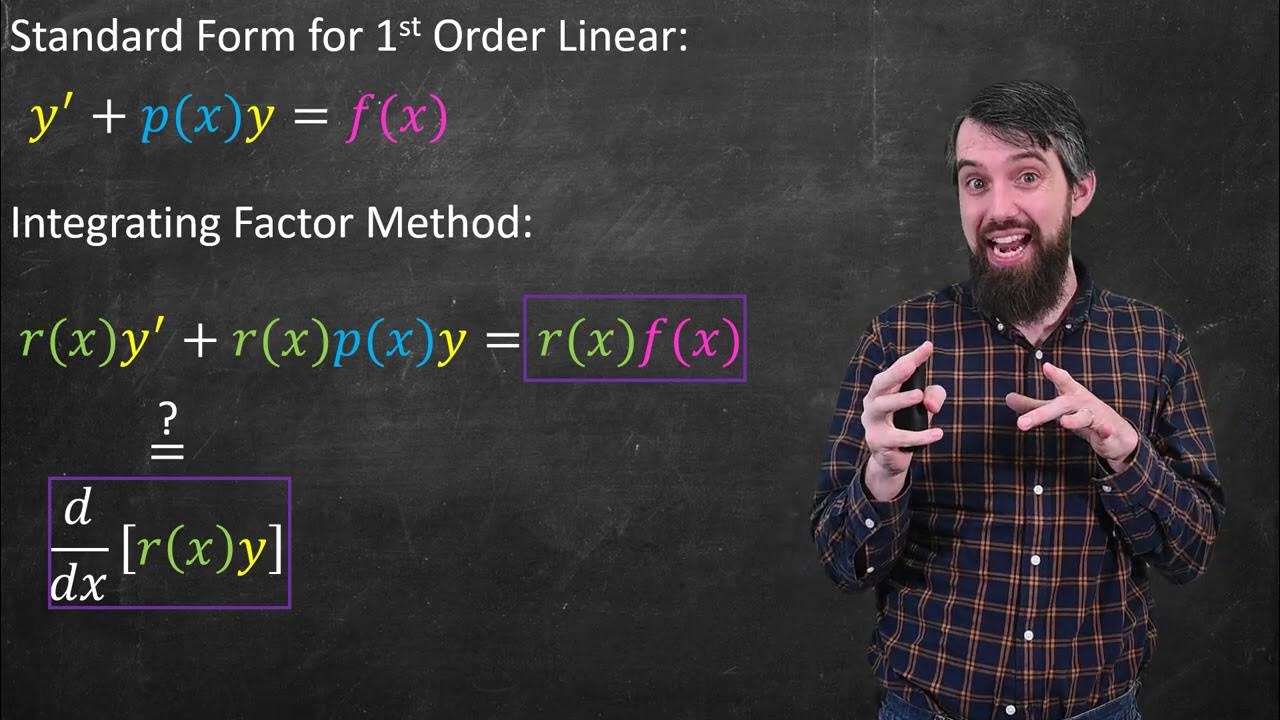Higher order homogeneous linear differential equation, using auxiliary equation, sect 4.2#37
TLDRIn this video, the instructor explains how to solve a third-order linear differential equation with constant coefficients. They begin by converting the differential equation into its corresponding characteristic equation and attempt to solve it through factoring. When factoring by grouping fails, they demonstrate a guess-and-check method to find possible solutions. After identifying one root, they use synthetic division to simplify the equation into a quadratic form, which is then solved using the quadratic formula. The video concludes with constructing the general solution using the identified roots and emphasizing their linear independence.
Takeaways
- 📚 The video tutorial focuses on solving a third-order linear differential equation with constant coefficients.
- 🔍 The characteristic equation is derived from the differential equation, with Y'' corresponding to \( R^2 \) and \( Y''' \) to \( R^3 \).
- 🔑 The equation is transformed into a characteristic equation of the form \( R^3 - 6R + 4 = 0 \).
- 🚫 Factoring by grouping is not straightforward due to the nature of the third-degree polynomial equation.
- 🔎 Potential solutions for \( R \) are guessed by examining the constant term, considering the factors of 4 (±1, ±2, ±4).
- 🎯 It's discovered that \( R = 1 \) is a root of the characteristic equation by substitution.
- 🌟 The factor \( R - 1 \) is identified, allowing the equation to be factored further.
- 📉 Synthetic division is used to divide the polynomial by \( R - 1 \), resulting in a quadratic equation.
- 📐 The quadratic formula is applied to solve for the remaining roots, yielding two complex roots.
- 🌱 The general solution to the differential equation is constructed using the exponential function \( e^{RT} \) with the found roots.
- 📝 The final solution is expressed as a linear combination of the exponential terms, with constants \( c_1, c_2, \) and \( c_3 \) to be determined by initial conditions or boundary values.
Q & A
What type of differential equation is being discussed in the video?
-The video is discussing a third-order linear differential equation with constant coefficients.
What is the significance of having constant coefficients in the differential equation?
-Constant coefficients allow us to solve the differential equation using the characteristic equation method, which is similar to the approach used for second-order linear differential equations with constant coefficients.
How does the video suggest converting the differential equation into a characteristic equation?
-The video suggests replacing the derivatives with powers of R, where Y''' corresponds to R^3, Y'' to R^2, and so on, and then setting the equation to zero to form the characteristic equation.
Why is the characteristic equation a third-degree equation in this case?
-The characteristic equation is a third-degree equation because the highest derivative in the original differential equation is the third derivative, hence the highest power of R in the characteristic equation is R^3.
What is the challenge mentioned in solving the characteristic equation by factoring?
-The challenge is that the characteristic equation has four terms and is a third-degree equation, making it difficult to factor by grouping in the usual way.
What method does the video recommend to find the roots of the characteristic equation?
-The video recommends guessing and checking possible values for R, based on the constant term of the characteristic equation, which is +4 in this case.
What is the first value of R that the video checks, and why?
-The first value of R checked in the video is -1. This is likely because -1 is a simple value and often a good starting point for checking potential roots.
How does the video confirm that R = 1 is a root of the characteristic equation?
-The video substitutes R = 1 into the characteristic equation and shows that the left-hand side equals zero, confirming that R = 1 is indeed a root.
What is the next step after finding that R = 1 is a root?
-After finding that R = 1 is a root, the video suggests factoring R - 1 out of the characteristic equation and then using synthetic division or long division to simplify the remaining polynomial.
How does the video solve the remaining quadratic equation after factoring out R - 1?
-The video uses the quadratic formula to solve the remaining quadratic equation, R^2 + 2R - 4 = 0, to find the other two roots of the characteristic equation.
What are the final forms of the general solution to the original differential equation?
-The general solution to the original differential equation is a linear combination of three terms: e^(1t), e^((-1 + sqrt(5))t), and e^((-1 - sqrt(5))t), where the coefficients c1, c2, and c3 are determined by initial conditions or boundary values.
Outlines
📚 Introduction to Solving a Third-Order Linear Differential Equation
This paragraph introduces the process of solving a third-order linear differential equation with constant coefficients. The speaker explains that the presence of the third derivative indicates a 'third water' situation. The equation is transformed into its characteristic form, which is a cubic equation. The challenge lies in solving this cubic equation, which is not straightforward due to the four terms involved. The speaker suggests that factoring by grouping is not feasible and hints at the need for guessing and checking potential solutions based on the constant term of the equation.
🔍 Factoring and Solving the Characteristic Equation
The speaker dives into the method of solving the characteristic equation by guessing and checking possible values for 'R', which are the factors of the constant term, four in this case. After testing -1 and finding it not to be a solution, the speaker correctly identifies 1 as a root, leading to the discovery that (R - 1) is a factor of the polynomial. The paragraph concludes with the use of synthetic division to simplify the cubic equation, resulting in a quadratic equation that needs further solving.
🧩 Completing the Solution with Quadratic Equation and General Solution
The paragraph begins with the application of the quadratic formula to solve the resulting quadratic equation from the previous step. The speaker finds two real roots, which, along with the previously identified root of 1, gives three real roots for the characteristic equation. These roots are then used to construct the general solution of the original differential equation, represented as a linear combination of exponential functions with the roots as exponents. The speaker outlines the process of multiplying each root by a constant and summing them to form the complete solution.
Mindmap
Keywords
💡Differential Equation
💡Characteristic Equation
💡Coefficients
💡Factoring
💡Polynomial
💡Synthetic Division
💡Quadratic Equation
💡Quadratic Formula
💡Roots
💡General Solution
💡Linear Independence
Highlights
Introduction to solving a third-order linear differential equation with constant coefficients.
Transformation of the differential equation into a characteristic equation.
Challenge of solving a third-degree equation with four terms.
Explanation of why factoring by grouping is not applicable.
Approach to guess and check for the values of R by examining the constant term.
Checking potential R values such as ±1, ±2, and ±4.
Process of elimination to find that R equals -1 does not satisfy the equation.
Confirmation that R equals 1 is a solution through substitution.
Factoring out R - 1 from the polynomial equation.
Use of synthetic division to simplify the polynomial after factoring.
Identification of the remainder to ensure the factorization is correct.
Reduction of the original cubic equation to a quadratic one.
Application of the quadratic formula to solve for the remaining R values.
Explanation of the arithmetic involved in applying the quadratic formula.
Finding two real roots for R using the quadratic formula.
Construction of the general solution using the identified R values.
Description of the linear independence of the solution's building blocks.
Final expression of the solution as a linear combination of the building blocks with constants c1, c2, and c3.
Transcripts
Browse More Related Video

Solving Polynomial Equations By Factoring and Using Synthetic Division

Solving Higher-Degree Polynomials by Synthetic Division and the Rational Roots Test

Solving Quadratic Equations With Exponents

How To Find The Real & Imaginary Solutions of Polynomial Equations

How to Solve Constant Coefficient Homogeneous Differential Equations

Linear Differential Equations & the Method of Integrating Factors
5.0 / 5 (0 votes)
Thanks for rating: